Share this article
This is part 2 of a travel series about my travels to Dolpo. Read Part 1: Planning the Journey.
After an impeding weeklong stay in Jumla – a small town in Western Nepal - Nyima, my local guide, Tsering, my supposed protector, and I, began our trek, walking eastward towards Dolpo.
Our route was calculated – or so it seemed – after two to three days of trekking we were to meet a yak caravan who would lead us across vast open terrain and steep mountain passes, all the way to the forbidden land, Dolpo.
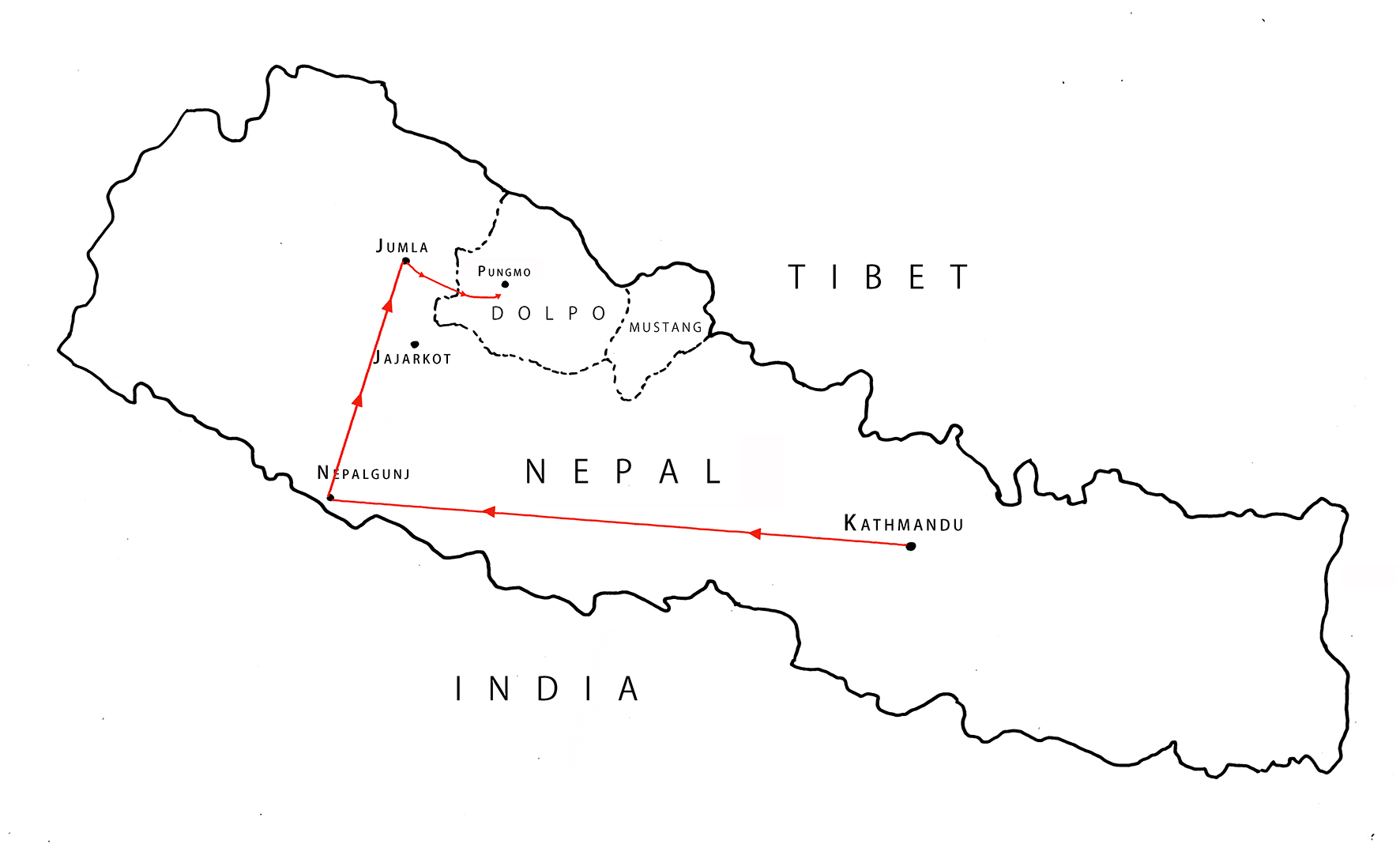
Route taken in Dolpo
Back to basics – A Village Home in Rural Nepal
By nightfall we reached Nyima’s house, which coincidentally happened to be on our way, where we spent the night. His home, quite unimaginable and difficult to describe, was the most basic, roughly built house. Built from stone, inside and outside, and hardly any furniture inside, it felt more like a cave than a home. The primitive structure comprised of a main room, quite tiny according to my memory, with two smaller adjoining rooms, with one or two old and worn-out carpets laid on the cold mud floor. This is where we would sleep, together with the whole family – a family of about seven members!
Such houses did not have bathrooms, let alone a simple toilet. The village was void of running water. Water, to cook, clean and drink has to be carried in large vessels from a nearby stream. These experiences serve as a good lesson to us – brought up with the luxury of such necessities like running water in the home – it brings us to value basic needs and simplicity.
It was dark. The only spec of natural light came through a small hole in the ceiling, made to hypothetically extract smoke from the indoor wood fire. Ineffective in doing so, the walls were completely covered in black soot. The dense smoke made it difficult to breath and naturally, the whole family was coughing. This was probably the most arduous house I have ever stayed in. Absolutely too ‘smokey’ indoors, and biting cold outdoors – I found myself going in and out, back and forth.
At that time in western Nepal (and for most parts of rural Nepal), people lacked knowledge about the use of a chimney duct. A typical house would set alight an open fire on a stone part of the floor in the middle of the room with a square hole above it through the ceiling. This seemed to occur in most houses with their inhabitants complaining about excessive coughing – but never recognised the association between the smoke they lived in, and their recurring and worsening cough. I tirelessly explained this link and even suggested how to make a simple effective smoke duct – by up-cycling tin boxes from cooking oil – but to no avail…
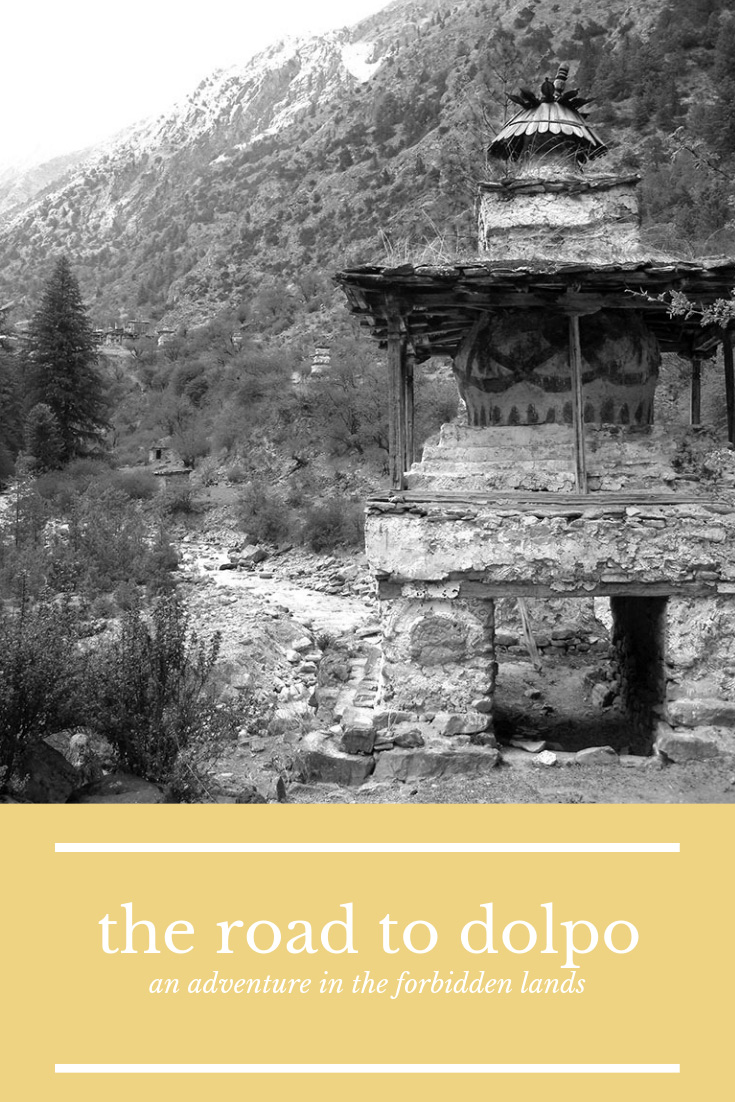
Several years later as I travelled across many other remote areas in Nepal, the concept of smoke extraction was introduced with most houses installing heavy cast iron stoves and smoke ducts from China (as seen below right). Finally it became a little more comforting to share conversations and meals with locals in their homes without the feeling of suffocation!
As a ‘white face’ travelling in Nepal’s most remote areas at that time, all locals think you can act as a medical doctor and have the medicines they need to cure them! Without much medical knowledge I helped when I could with simple medicines. It’s somewhat comical to think that ‘Westeners’ travel to these places in Asia as though to find to some kind of magic, whilst locals perceive foreigners to be magicians due to the fast effects of western medicines.
During the course of the night at Nyima’s house, in my sleep I thought I heard some groaning and moaning… I did not think much about it. Only in the next morning to see Nyima’s wife cradling their first new born baby delivered that same night – standing and going on with her daily routine as if nothing happened! I was somehow feeling bad to take her husband away to continue the journey – but no one seemed to mind as much as I did.
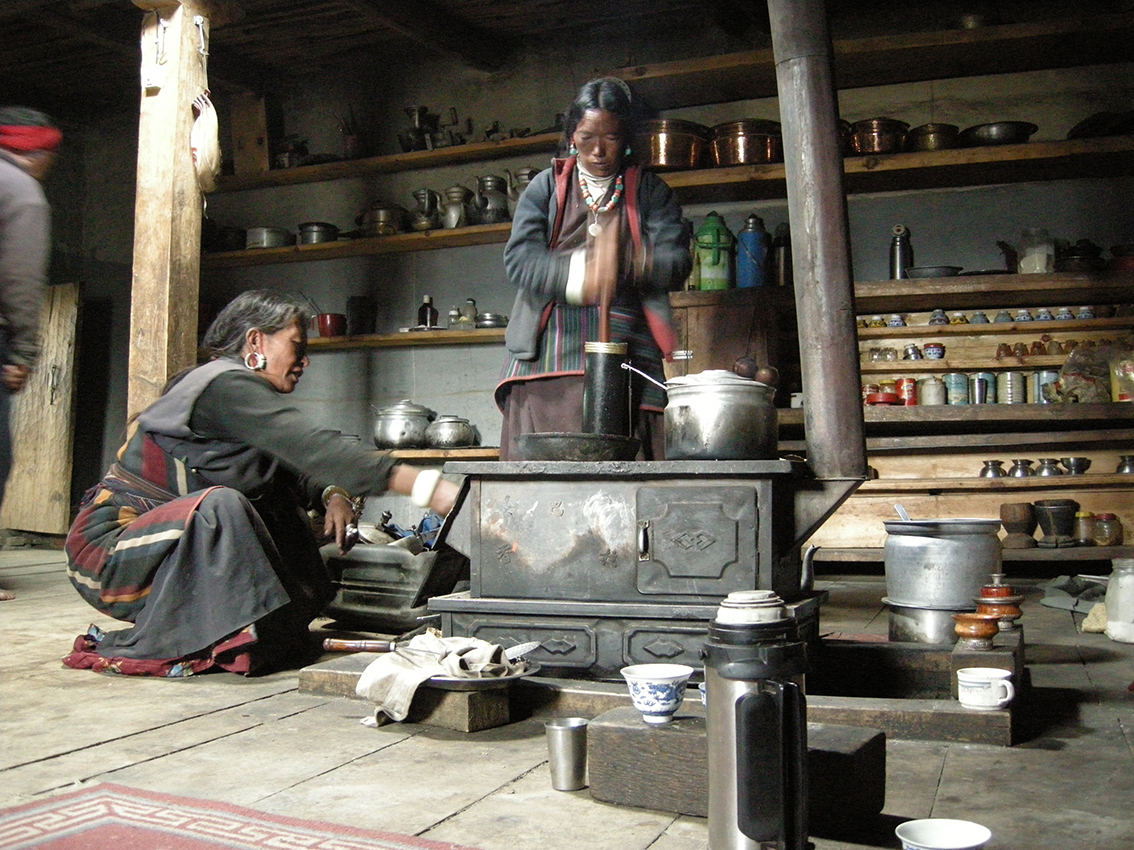
Later in Dolpo, new stoves and smoke extractors were introduced in homes. Here you can see a local woman making Tibetan Butter Tea.
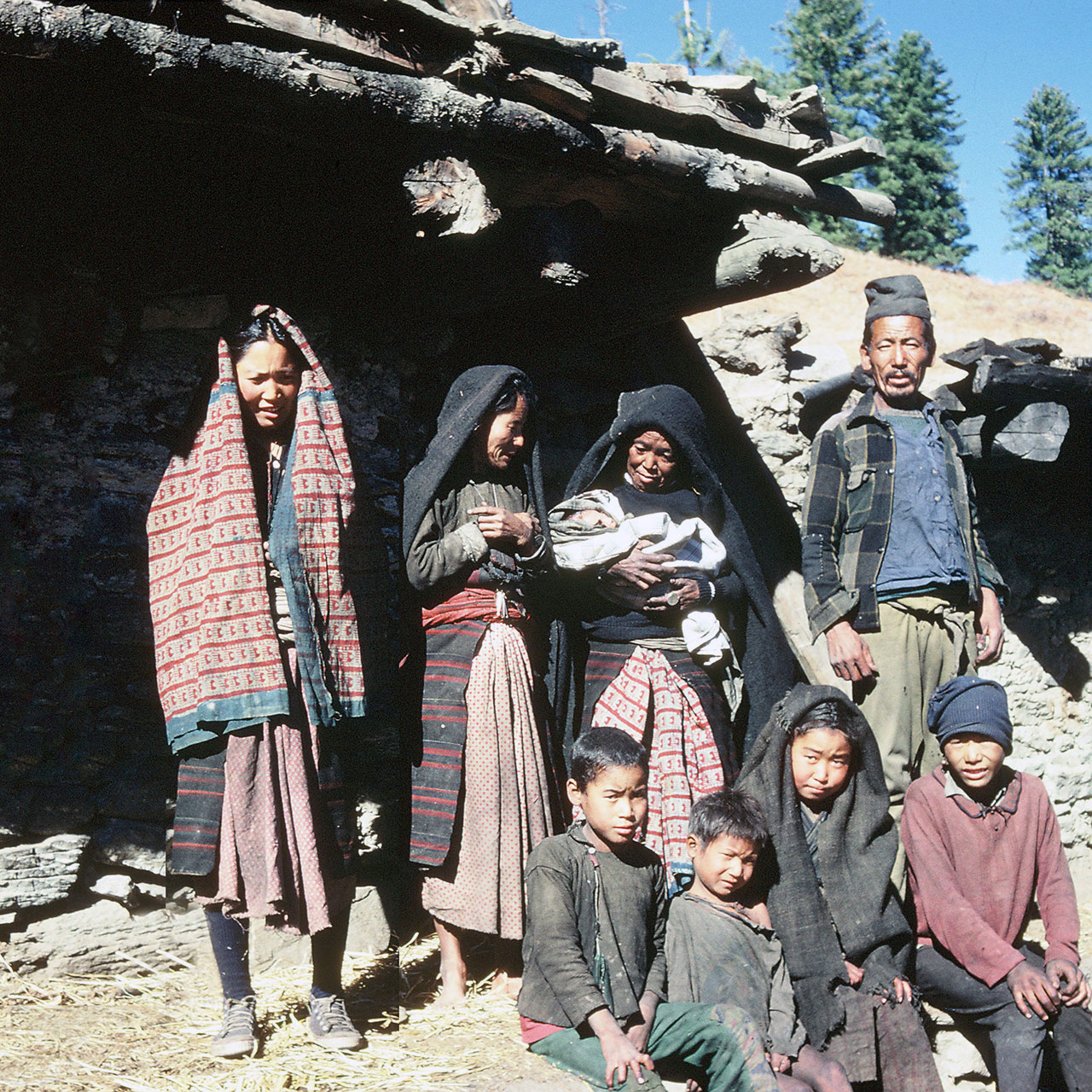
Nyima’s mother in law cradling the baby as the new mother (far left) is standing quite in shape as though nothing happened.
Check-Post Crossing
Nonetheless, the journey continued. We had to cross a check-post, which we planned to cross at night to avoid being noticed. We stopped in a house on the way belonging to an old lady who luckily seemed not to know what was going on, nor did she query why we were leaving at night. Amazing!
At around 11pm we began our expedition. We had to cross a small bridge and then run up a mountain! Nyima was to go through first and give signal to proceed with his flashlight. Meanwhile Tsering and I eagerly waited behind a bush. But frankly there was nowhere to really hide with the full moon shining bright that night!
Nyima moved and gave the signal to proceed, but Tsering was so scared, he could not move. Nyima hurriedly returned back urging us to move fast and persuasively pulled Tsering across. Luckily there were no dogs around - who could have woken up anyone in the check post - and we dashed across the bridge and made our way to mount a steep snowed mountain. We had to walk up the mountain under the beaming moonlight and luminous white snow, whilst Nyima was slipping and sliding in attempt to climb up the snowy mountain slope with the new shoes I had just bought him! What a night trek… I felt everyone could hear my heart beating so hard!
As we finally made it over to the other side of the mountain, Nyima and I burst into laughter, relieved that the mission was successfully completed and we could now rest and enjoy a rewarding bite.
In the meantime, we could see Tsering consumed with worry. He nearly messed up everything… this tall and strong but coward Khampa! ('Khampas' are traditionally known as the warrior tribe in Tibet - very courageous, fearless and independent minded people).
A Journey with a Yak Caravan
I vividly remember the next day to be a rather pleasant one and very relaxed compared to the stressful night walk the day before. We enjoyed a lovely meal remarkably prepared by Nyima, with so few facilities. I spotted him cooking an egg on a hot rock surface whilst making a spice blend on another part of the same rock, using a small stone to crush the ingredients into a paste. Somehow he hardly needed any kitchen equipment. Amazing!
The yak caravan was due to arrive any moment… yet we had no sight of them for another 3 days! There was no mean of communication at that time except walking to meet someone and give him the message.
Tsering’s fear heightened. After many discussions, he finally decided to end the journey and return back to Jumla. Now we were two, and I was really relieved to see him go as he may have hindered our progress instead of providing me protection. Today, as I take some moments to relive the experiences as written in my journal at that time, I am quite surprised! I really must have been relieved beyond belief to see Tsering go away because that is all I wrote about – the troubles he was giving, his fears and uncertainties! At times I felt concerned that he would unveil the plans of this ‘forbidden’ trip – but then again, assuming he would be too scared to mention it because of his involvement, helped me feel reassured.
No villages were in sight. We were in the middle of nowhere with a tiny tent I did not dare to open. The nights were cold. We found a spot, sheltered from the biting winds, where Nyima and I managed to keep warm for the night. We spent a few chilly and relaxed nights outdoors, wondering when the caravan would arrive. Ultimately they would have to pass from here - it is their route back home to Dolpo after all - we just did not know when…
In the 80’s the yak caravans were still travelling the north of Nepal. They would go to Tibet where they exchange the grains they collected from the south with the salt from Tibet. They would travel north in summer and travel south in winter.
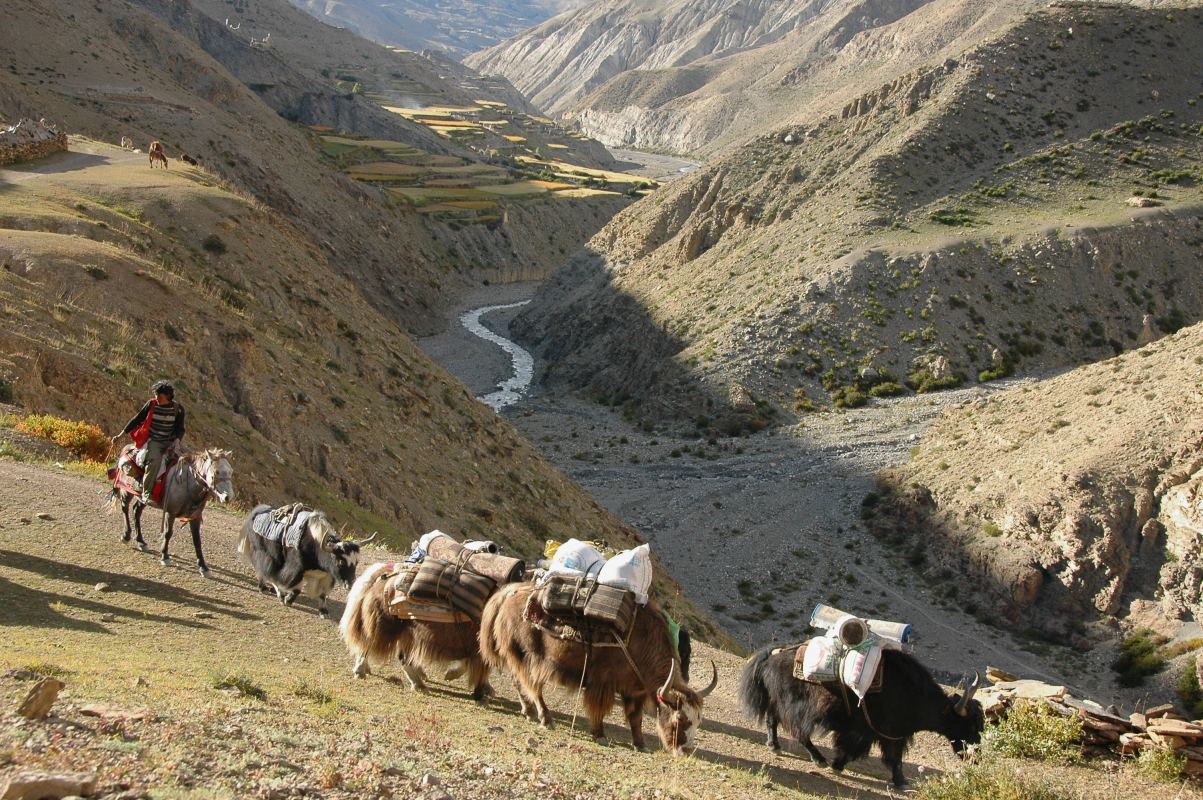
Yak Caravan | Wikipedia Commons
The yak caravan finally arrived and we were thrilled! There were about 12-15 yaks, the caravan chief and four other attendants. It was imperative to join them to be able to cross Tibrikot, a village on the way to Dunai, where we would enter the restricted Dolpo area. This was the most delicate part of the journey ahead.
My backpack was now placed on a yak and hidden under a traditional Dolpo blanket. I wrapped myself up in a chuba (typical Tibetan coat, as seen in the picture below) that would keep me warm and partly disguise my western appearance – yet it was difficult to do so completely as my bright red socks and western trekking boots were not very discreet. I also took great care not to wash myself, especially my hands and face, as not to appear too white!
Making our way from Tibrikot to the entrance of Dolpo was the most challenging path - one where I should not be noticed. I tried to imitate the locals way of walking, side to side like a metronome, blending in, and trying to keep pace at the end of the caravan whilst twisting the yak’s tail shouting “ya ya ya!” They had left me with the slower yaks at the end of the caravan. So I had to do my part and make sure the yaks were advancing.
It was challenging to walk all day, non-stop for 6-7 hours each day… whilst pushing the yaks! Yet a very interesting experience to be part of such a caravan in the highlands - a reminiscence of all central Asia caravans. We slept outside each night in the dead of winter in the high altitudes. It was cold, but not as bad or uncomfortable as one would imagine. The people of the caravan would create a wall around our sleeping camp - with the sacks of the grains or salt they were carrying – to shield everyone from the freezing winds.
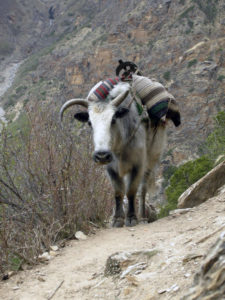 The grains and salt were transported in beautifully rough hand-woven sacks made with yak wool (as seen in the picture on the right). They had linear designs alternating off-white and natural wool colour and nearly black, also the natural colour of yak wool.
The grains and salt were transported in beautifully rough hand-woven sacks made with yak wool (as seen in the picture on the right). They had linear designs alternating off-white and natural wool colour and nearly black, also the natural colour of yak wool.
As we were about to reach Dunai, two Nepali men joined the trail at the back and approached the Caravan chief on his horse and inquisitively asked “who is that?” pointing at me. “This is a Lama” (a Tibetan Monk), the chief answered. “American Lama?” Obviously noticing my red socks and boots! Confidently the chief replies assertively ”No, this is a Lama from Mugu.” (Mugu, a district west of Dolpo).
The two Nepali made their way towards me. Frightened at the fact that they wanted to talk to me and may discover my true identity, I began to chant and speedily mumble Tibetan mantras (prayers) – they would not dare to disturb a Lama during his prayer – I thought! With no shame, they began to speak to me in Nepali. Yet I could not grasp what they were saying, neither would my companions in the caravan. And since they were from the area, they had little fluency in Tibetan language, but luckily much less than I did.
In Tibetan, they asked me about my shoes. With my eyes heavily squinted so that they could not see my bright blue eyes (luckily the sun was in front of me), I replied in Tibetan that a foreigner donated the shoes because I had problems with my feet. I continued to mumble mantras. Somewhat convinced with that, they went on, believing I may be a local, even if a strange one, thanks to my knowledge of Tibetan. That was close!
This episode still leaves me astounded! The way events rolled out and how they could believe I was a Lama is incredible.
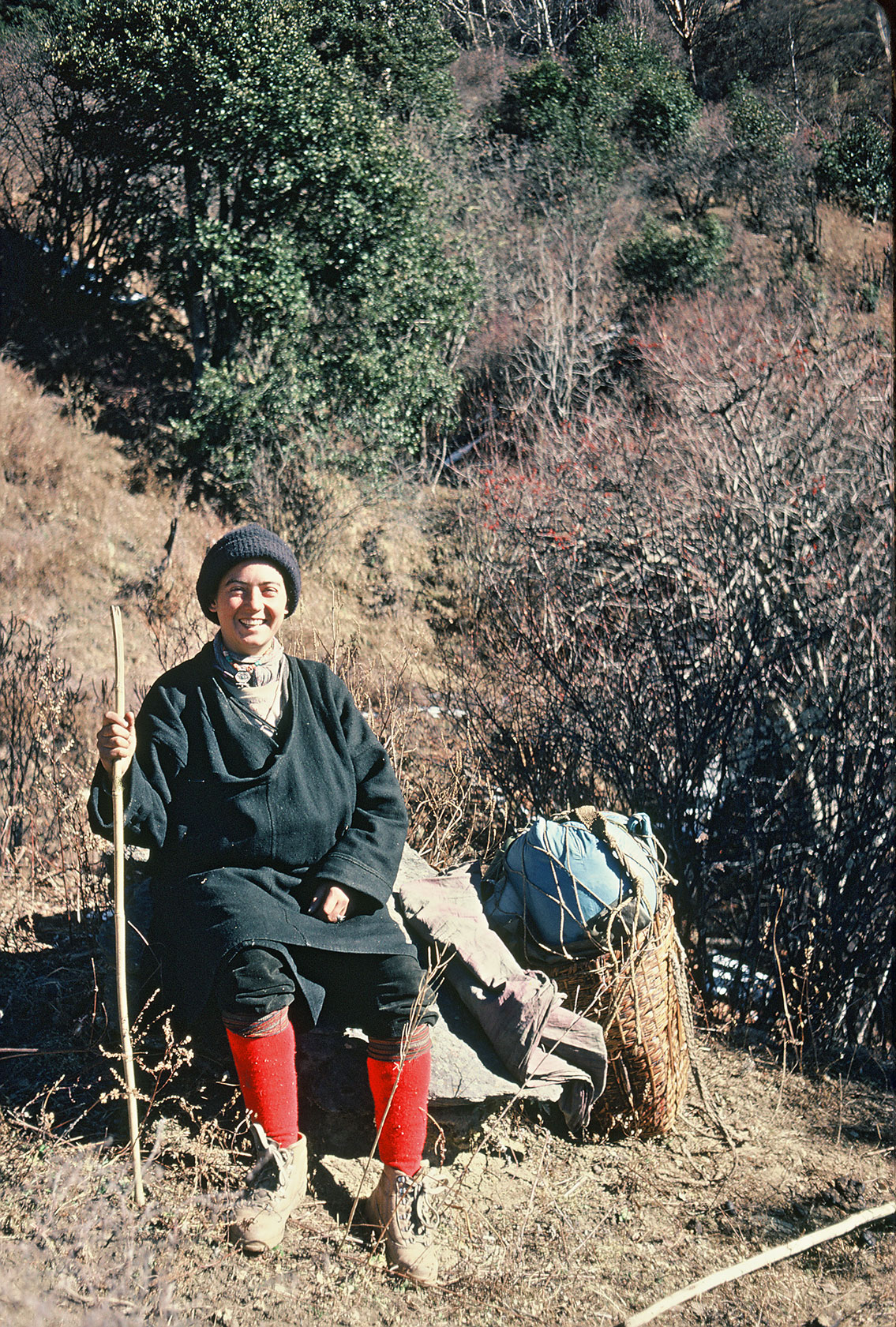
Arriving in Dolpo
The two Nepalese men continued on to Dunai, however we turned inside the valley toward the north to get into Dolpo.
We arrived in a place where we could set up camp. I inquired with the yak caravan chief why he presented me as a Lama. Confidently he said, “It worked, didn’t it? So what’s the problem?!” I laughed it off, astonished at this free spirit and conviction. The evening went on sharing food and laughter with all those accompanying the caravan, as well as the people in the small village were we stopped for the night.
Finally I was in Dolpo! My excitement levels heightened as I continued to meet people and discover the area. As I wandered around I would meet women mostly spinning wool from morning to evening.
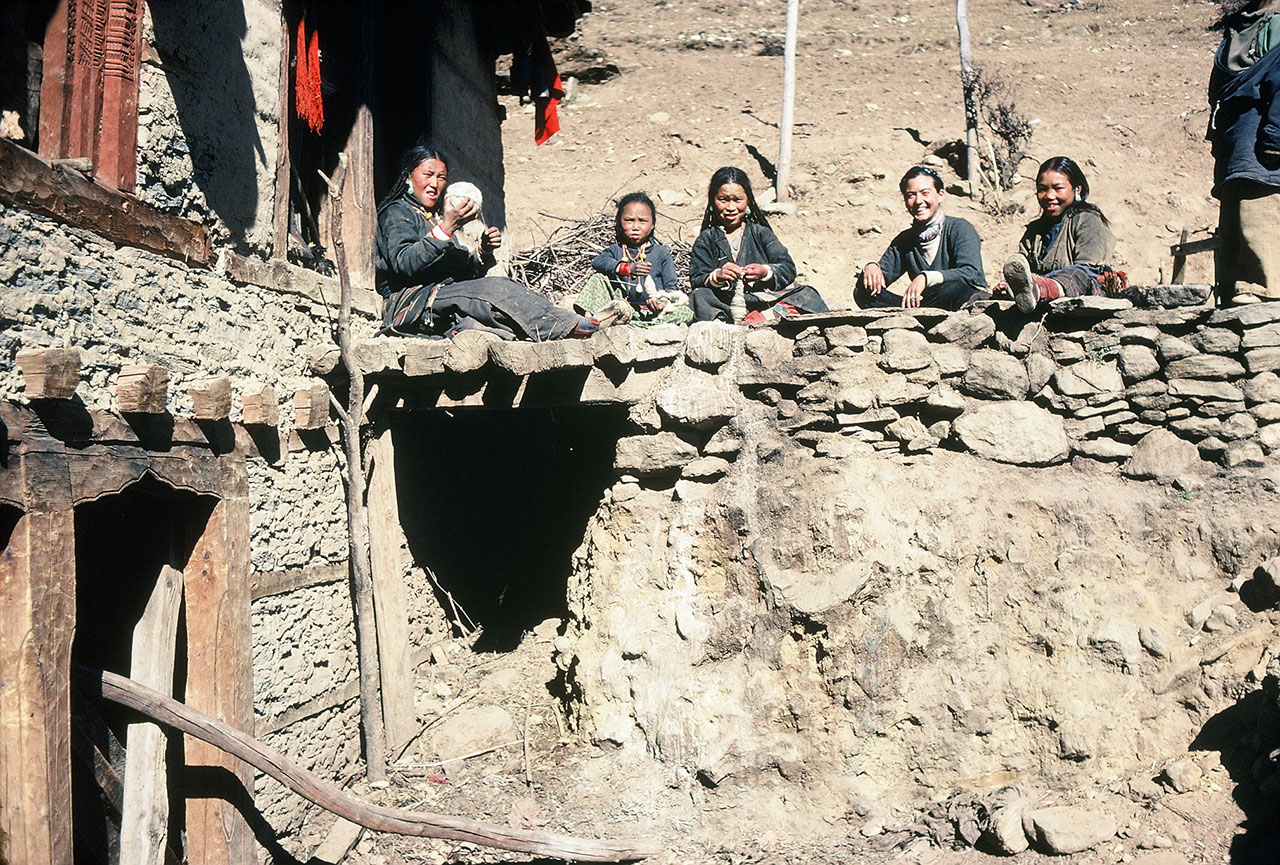
Sitting with women from upper Dolpo (they come in lower Dolpo during the winter) most of them engaged in spinning wool.
We travelled for more days undisturbed and reached Pungmo village. There I passed under a typical Stupa (Buddhist shrine) of that area marking the entrance of Pungmo village, with beautifully painted mandala and deities on the ceiling. Stupas in Dolpo and Mustang have a specific attractive architecture in terms of shape, colour and the emotion it creates. I could not take photos, as my camera would have attracted undue attention. I found it so difficult not to shoot these beautiful structures.
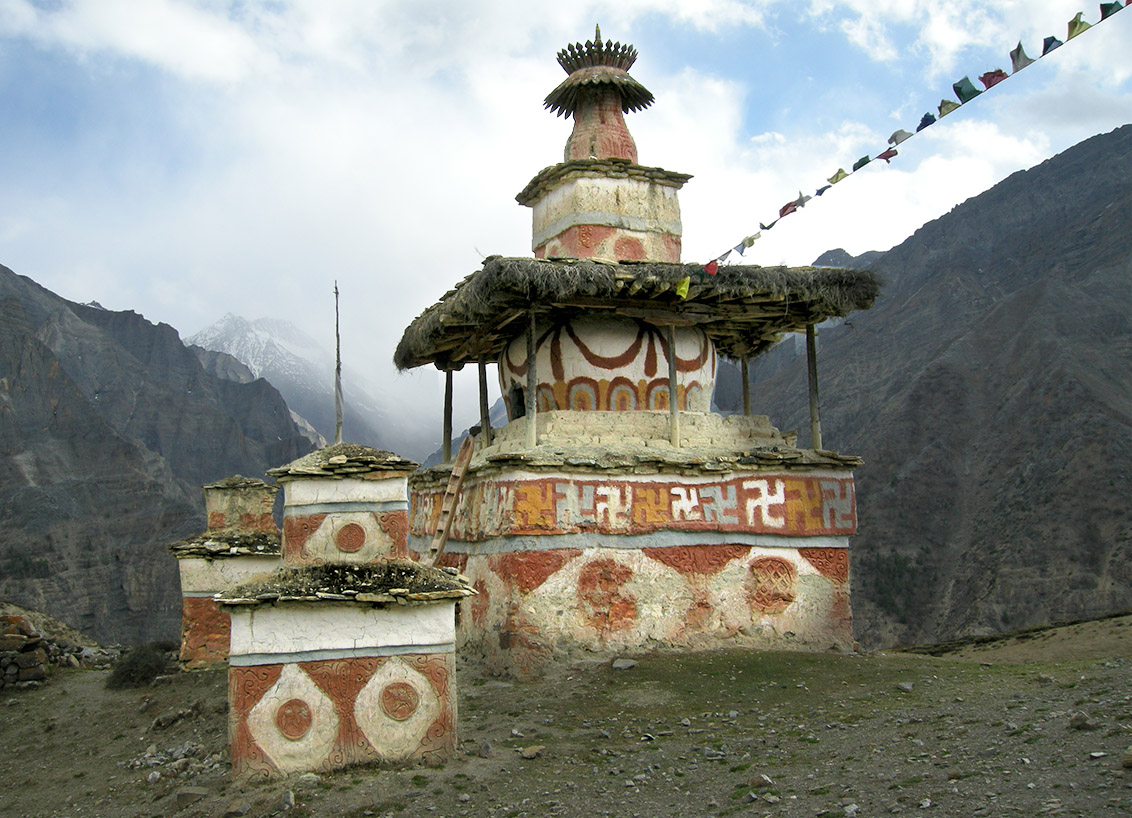
Traditional Dolpo stupa in Samling monastery. Photo taken on a later travel where I finally reached Samling | Note the swastikas on the stupa, these are a very ancient and traditional spiritual positive symbols for hinduism, Buddhism and Bön (later stolen by the Nazis, not respecting the original meaning).
Our stay in Pungmo was short-lived. We hurriedly passed through to avoid being seen by the village’s Nepalese official (each village had a secretary from the Nepalese administration as well as a local chief). We then pursued our journey and hiked over a steep mountain onward to the remote Thegchen Rabgye Ling Monastery, where a famous Lama, Geköd Rinchen Gyaltsen, was officiating.

Lama Geköd Rinchen Gyaltsen at the Thegchen Rabgye Ling Monastery, Dolpo.
My plan was not to stay there, but to go further North, to Upper Dolpo. I particularly wanted to go to the famous Bön monastery of Samling; perhaps the most important Bön monastery in Dolpo, where so many old texts could be found. For many Bön Lamas, these old scriptures are treated as treasures, since some were the unique remaining copies left after so many important texts were lost in Tibet.
I was dissuaded to travel North. Everyone would tell me “It’s too cold now, too much snow, you will die! Even locals do not travel north at this time of the year.” I probably listened to such remarks from more than 50 people before I finally accepted and ‘let go’ – to a certain extent – of the idea of pursuing my journey further north. They were right. To get there, I had to trek over at least two very high mountain passes of more than 5200 metres above sea level which, given the fact that it was mid of December, the peak of winter, would be completely blocked and impassable. It was really difficult to change my mind. I somehow felt I miscalculated my trip and I felt slight resentment towards the person who advised me to go there in winter…
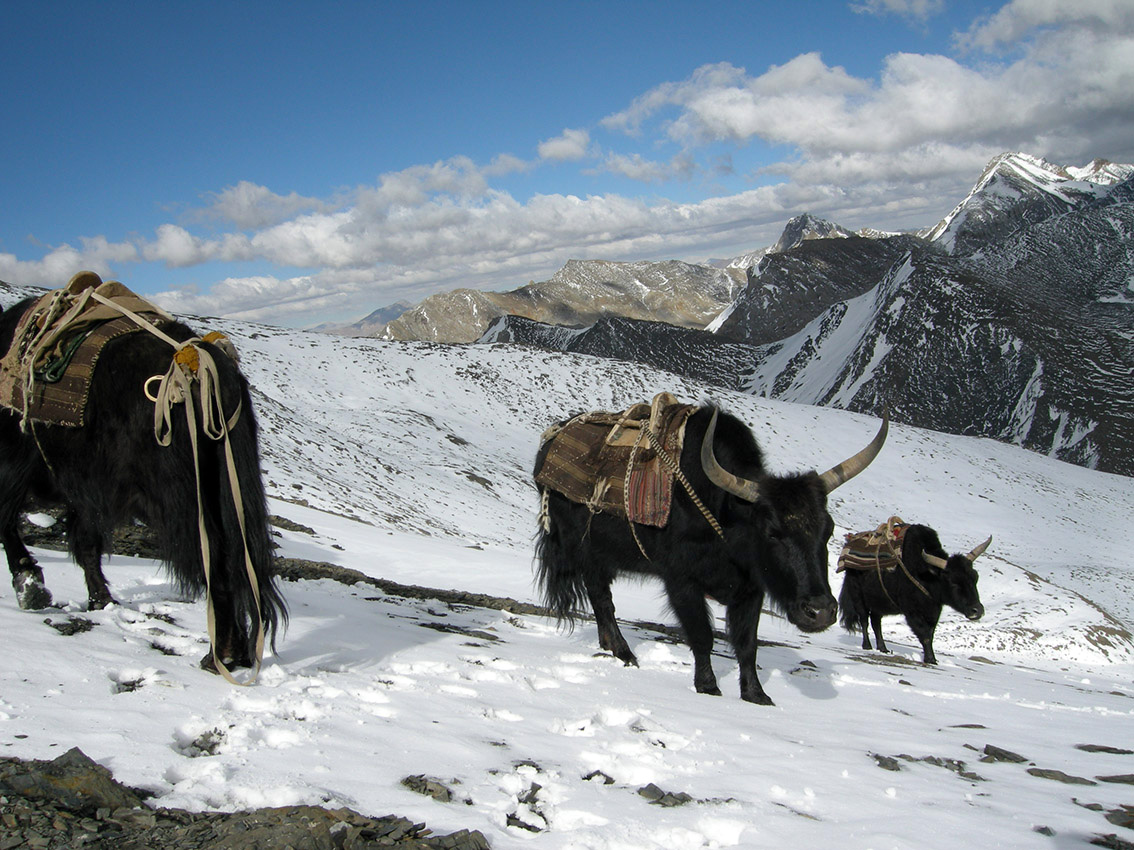
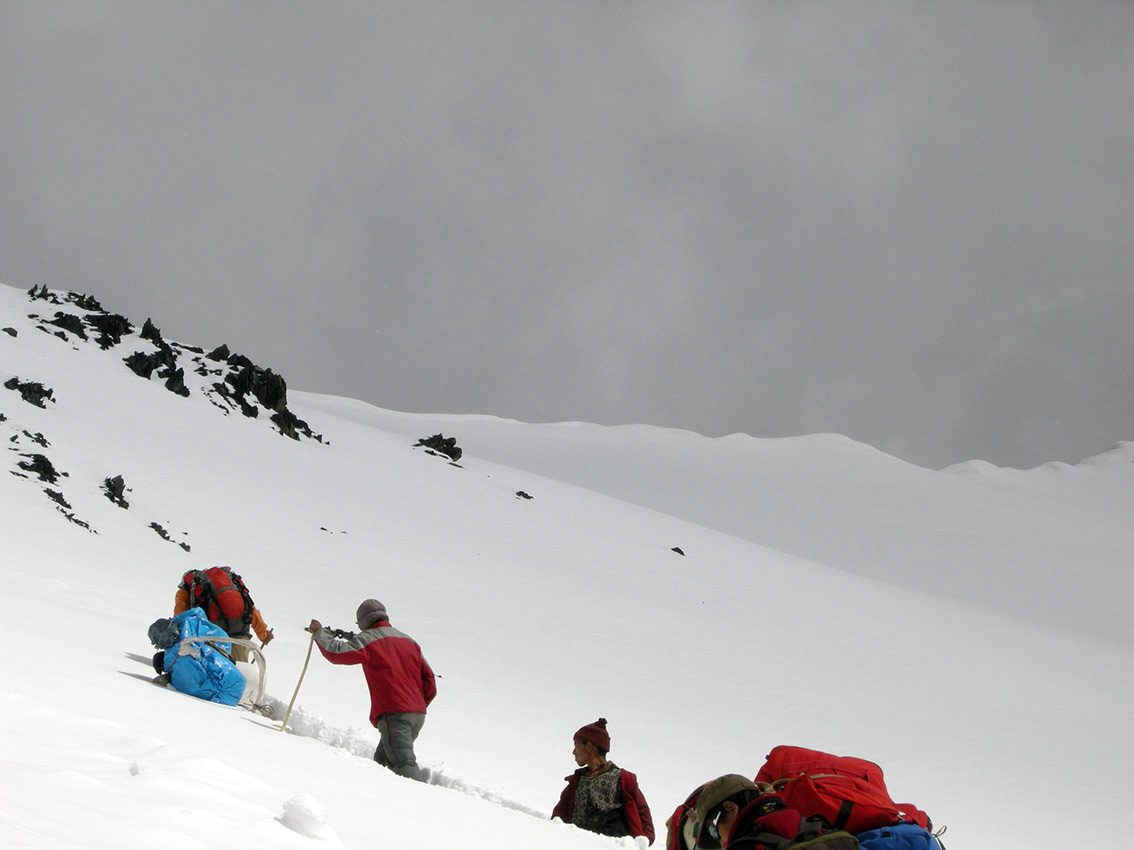
Photos taken on a later travel, end of May, showing how much snow there is even in May. We nearly did not make it up the pass. So it is clear I could never have crossed one of those passes in December!!
Click here to stay tuned on how the story develops – in the next chapter I observe a traditional Tibetan Purification Ceremony, another episode of strange occurrences and adventures!
About Marina Vaptzarova
Designing and creating conceptions has been part of her professional life for over 25 years. During this period, Marina revisited the traditional raw materials, craftsmanship and skills of Nepal and transposed these into contemporary design handicrafts and accessories. Her designs are fully experienced by the customer and play a prominent role in addressing the needs of the hospitality sector.
Marina Shrestha is a specialist consultant designer for interior handmade accessories in the hospitality sector, particularly in the luxury boutique segment. She also provides consultation on product development for handmade crafts.
Share this article

